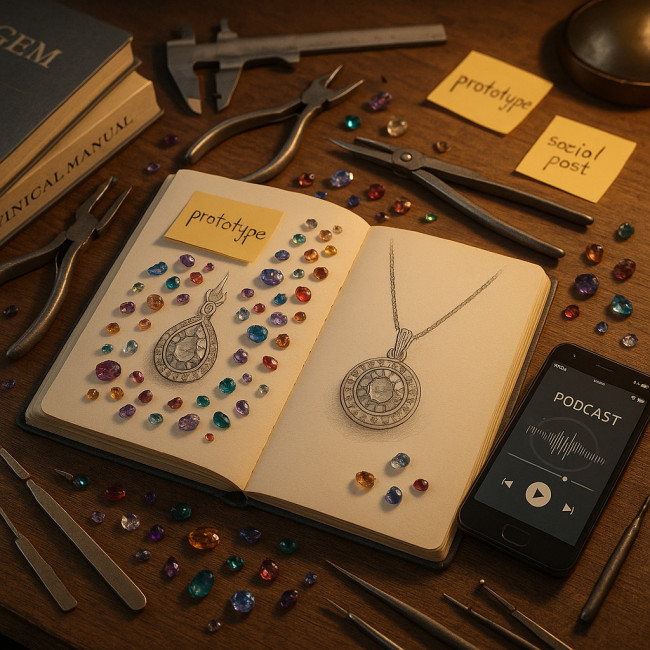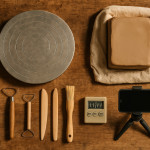Self-directed learning guide: books and podcasts every jewellery designer needs
Looking to sharpen your stone-setting, modernise your marketing and future-proof your studio—all on your own schedule? This self-directed learning guide curates the most impactful books and podcasts for jewellery designers, then shows you how to weave them into a practical upskilling plan that sticks.
Why self-directed learning turbocharges your jewellery career
Formal courses are powerful, yet they often clash with production deadlines or feel generic. A self-directed learning programme lets you tailor content to the collections you are prototyping today, while taking advantage of commute time, bench breaks or polishing sessions.
The E-E-A-T advantage
Google now champions Experience, Expertise, Authoritativeness and Trust. Curating reputable learning resources—and documenting how you apply them—signals expertise to potential buyers searching marketplaces such as craft-designer training hubs. Show prospective clients you continuously invest in your craft and you vault ahead of stagnant portfolios.
Foundational books every jewellery designer should own
Below are seven titles vetted for depth, clarity and immediate application in a studio environment. Mix technical manuals with business playbooks for balanced growth.
| Book | Focus | Why it matters | Time to read |
|---|---|---|---|
| The Complete Metalsmith by Tim McCreight | Bench techniques | Covers everything from soldering to patination in a single volume. | 12 h |
| Jewellery Design Sketchbook by Elizabeth Olver | Concept visualisation | Step-by-step drawing drills to translate ideas into clear briefs. | 8 h |
| Gemstones of the World by Walter Schumann | Gemology | Portable reference when sourcing recycled or ethical stones. | 10 h |
| Marketing & Selling Your Jewellery by Alison Branagan | Business | Practical templates for pricing, pitching and wholesaling. | 6 h |
| Creative Stonesetting by John Cogswell | Advanced techniques | Elevates bezel and tension settings to art-piece level. | 9 h |
| The Responsible Jewellery Handbook edited by RJC | Sustainability | Frameworks for ethical sourcing and traceability audits. | 5 h |
| Profit First for Creatives by Mike Michalowicz & colleagues | Finance | Cashflow system tailored to project-based studios. | 4 h |
Need deeper guidance on compliant raw materials? Pair the handbook above with our article on eco-certified metals that impress conscious clients.
Podcasts that fit into bench time
Earbuds let you learn while filing or polishing. The shows below deliver expert interviews, trend forecasts and case studies in 30-60 minute bites.
- Perceived Value – Narrative-style episodes where designers dissect pricing strategies and buyer psychology.
- The Jewellers Academy Podcast – Weekly technical deep dives alongside social-media growth hacks.
- Rapaport Diamond Podcast – Market analysis for anyone navigating recycled gemstone sourcing. Combine insights with our guide on recycled gemstone provenance.
- Creative Biz Rebellion – Perfect for scaling from bespoke orders to small-batch wholesale; complements thoughts in wholesale pack agreements.
- Jewellery Journey – Museum curators and historians offer context that sharpens your storytelling chops.
How to extract maximum value from each episode
- Note actionable tips in a shared document.
- Translate at least one idea into a micro-experiment within 48 hours.
- Post the result on social media and document metrics—this doubles as marketing content.
Build your personalised learning sprint
Borrow the sprint logic popularised in product design and apply it to jewellery skill building.
- Define a focus. Example: improve claw-setting aesthetics.
- Select one book + two podcast episodes.
- Allocate fixed slots. 30 min reading over morning coffee; podcast during shipping runs.
- Create a tangible deliverable. Produce a prototype ring before week's end.
- Share & reflect. Upload a 360° video using tips from virtual try-on demos. Gather feedback.
Tool stack that keeps you accountable
- Trello – Board lists: Reading, Listening, Prototypes, Posted.
- Notion – Swipe file of design prompts and gem combinations.
- Google Calendar – Recurring “Learning Block” so clients can't encroach.
- Digital Asset Vault – Organise files as described in our vault guide to speed future collections.
Common pitfalls and how to avoid them

Information overload tops the list. Solve it by committing to one book per month and unsubscribing from overlapping newsletters. Another trap is passive consumption. Every chapter should spawn a bench experiment or a pricing tweak. Finally, designers often ignore the business side—track profit margins with a weekly dashboard.
FAQ
- How many hours per week should I dedicate to self-directed learning?
- Most independent jewellers report strong progress with 3–5 hours. Split sessions into daily 30-minute blocks to minimise disruption.
- Do podcasts really replace formal gemology courses?
- No. Treat podcasts as supplements. For certification, pursue accredited programmes and use audio content for ongoing updates.
- What's the quickest way to apply book knowledge?
- Create micro-projects. After reading a chapter on enamelling, produce a single charm and post the process video the same day.
- How can I prove my new skills to retailers?
- Document each learning sprint in a portfolio section titled “Process & Progress”. Retail buyers love evidence of continuous improvement.
Self-check quiz: are you maximising self-directed learning?
Next step: turn learning into revenue
Pick one book and one podcast from this guide today, schedule your first 30-minute learning block, and commit to showcasing a new prototype on your feed within a week. Small, consistent action compounds into expert status and bigger commissions. Ready to start? Your future clients are.











